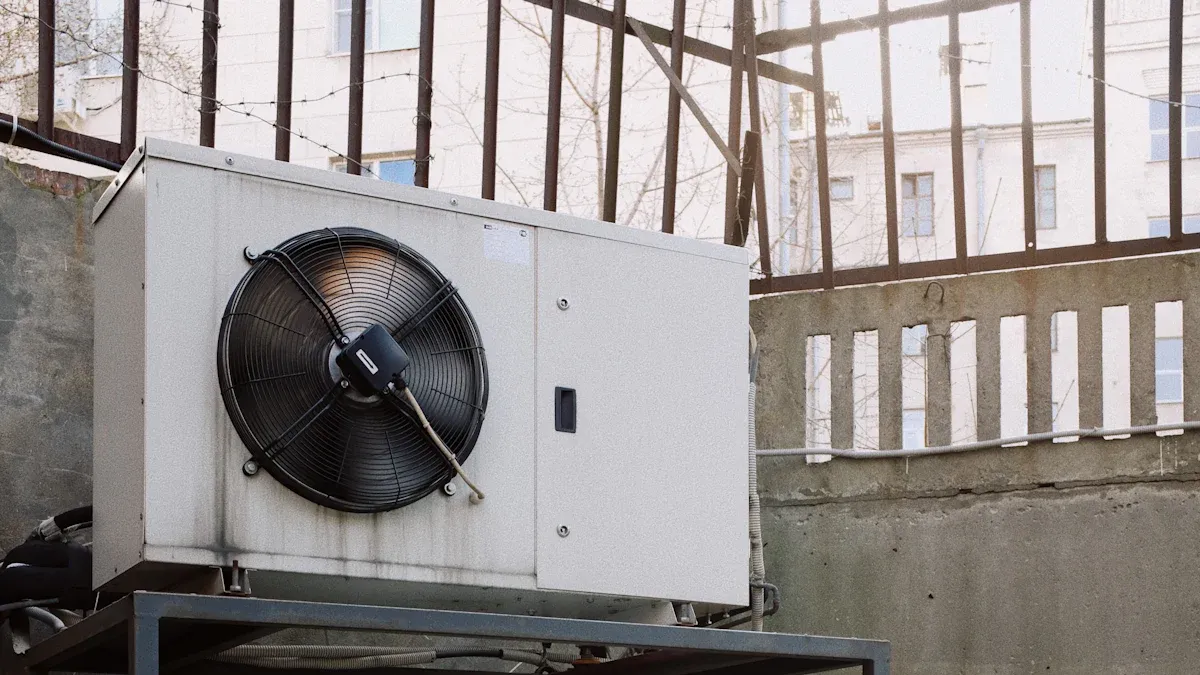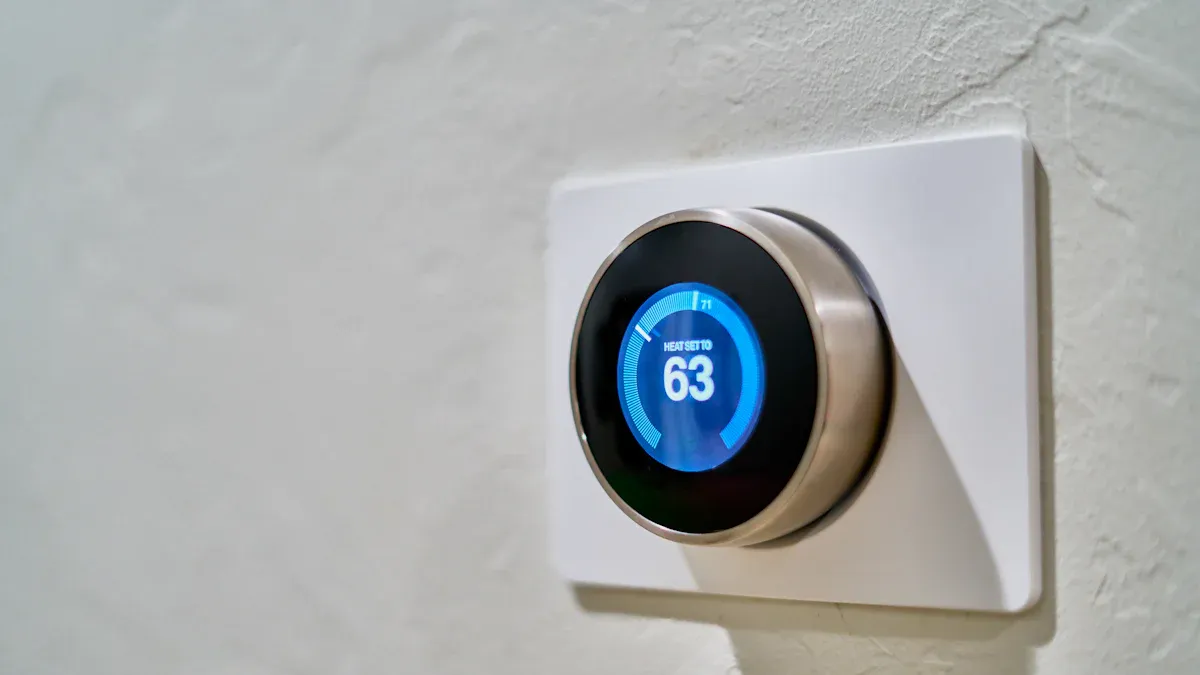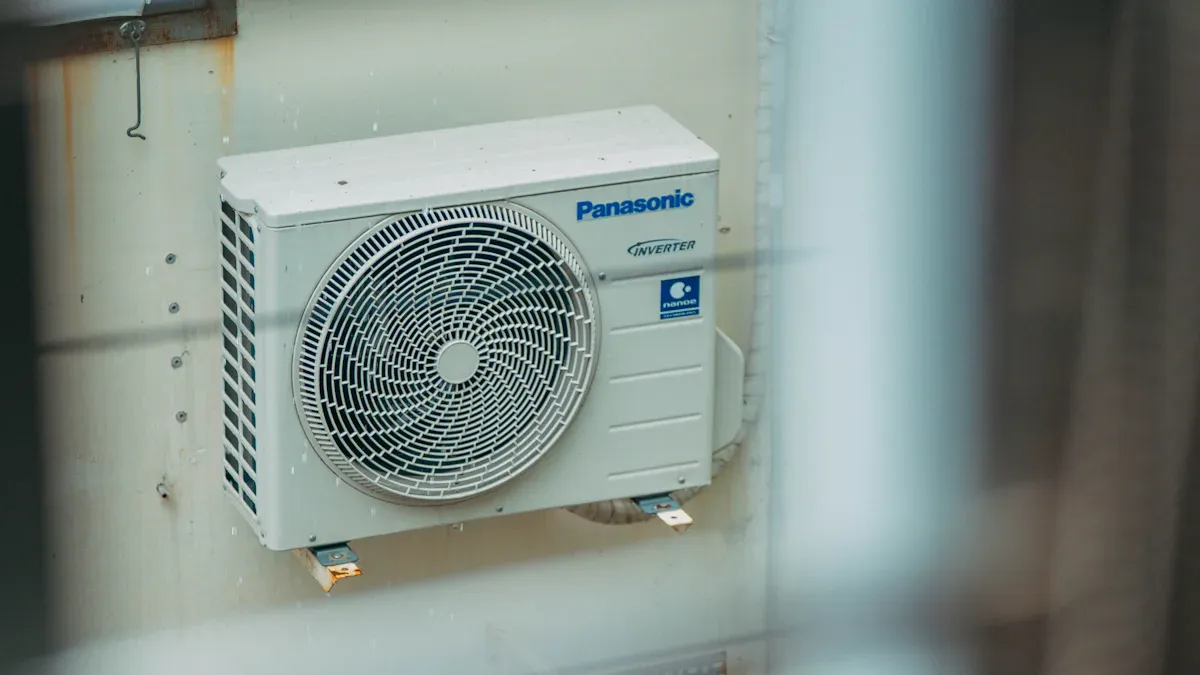
An air conditioning heater is a versatile system that keeps homes comfortable all year long. It cools in the summer and warms in the winter by reversing the refrigeration cycle. Unlike older systems, this technology combines two functions into one efficient unit.
Modern homes rely on these systems for better climate control and energy savings. For example:
- In regions like the GCC, air conditioning can use up to 70% of electricity during peak summer months.
- Energy-efficient systems with a 14 SEER rating or higher cut energy use and costs while reducing carbon footprints.
This makes air conditioning heaters a smart choice for eco-conscious homeowners.
Key Takeaways
- Air conditioning heaters cool and heat, giving comfort all year.
- They use less power than older heaters, cutting energy costs by half.
- Cleaning parts like the coil helps the system work better and last longer.
- These heaters are good for the planet, reducing harmful gases and using green energy.
- They fit different home sizes and designs, making them useful for many spaces.
What Is an Air Conditioning Heater?
Dual functionality for cooling and heating
An air conditioning heater is a unique system that combines cooling and heating into one efficient unit. It uses reverse-cycle technology to switch between these two functions seamlessly. During summer, it extracts heat from indoor air and releases it outside, keeping your home cool. In winter, it reverses the process, pulling heat from outside air—even in cold temperatures—and transferring it indoors to warm your space.
This dual functionality is made possible by a key component called the reversing valve. This valve allows the system to change the direction of refrigerant flow, enabling it to either cool or heat your home. Modern heat pumps, which are a type of air conditioning heater, excel at this process. They provide efficient heating at lower costs compared to traditional systems.
Tip: If you’re looking for a system that works year-round, an air conditioning heater is a smart choice. It eliminates the need for separate cooling and heating units, saving both space and energy.
Recent studies highlight the efficiency of these systems:
- They reduce heating energy consumption by up to 50%.
- Cooling energy consumption increases slightly but remains manageable due to improved efficiency.
| Aspect | Heating Energy Consumption | Cooling Energy Consumption |
|---|---|---|
| Baseline | 52% of Toulouse’s heating energy consumption | Increase from 54% to 6.3 GWd for cooling |
| Efficiency Range | 12% to 50% reduction in electricity savings | Increase in all scenarios due to AC systems |
How it differs from traditional heating systems
Air conditioning heaters stand out from traditional heating systems in several ways. Unlike furnaces that generate heat through combustion, these systems transfer heat using refrigerants. This process requires significantly less energy, making them far more efficient. While gas furnaces typically operate at 80–98% efficiency, air conditioning heaters boast efficiency ratings of 300% to 500%.
This stark difference in operation means air conditioning heaters can deliver the same level of comfort while consuming less energy. They also offer versatility, as they can cool your home during summer—a feature traditional heating systems lack.
Performance metrics further illustrate their advantages:
| Metric | Summer Improvement | Winter Improvement |
|---|---|---|
| Coefficient of Performance | 80% | 40% |
| Average Power Savings | 21.4% (dual-PCM) | 12.8% (dual-PCM) |
| Average Power Savings | 11.8% (single-PCM) | 18.5% (single-PCM) |
By combining cooling and heating capabilities, air conditioning heaters provide year-round comfort while reducing energy costs. Their innovative design makes them an excellent choice for homeowners seeking efficiency and sustainability.
Components of an Air Conditioning Heater

Understanding the key components of an air conditioning heater helps you appreciate how it keeps your home comfortable. Each part plays a vital role in the system’s operation. Let’s break it down.
Compressor
The compressor is the heart of the system. It pumps refrigerant through the entire unit, ensuring the cooling and heating processes work smoothly. When the system is in heating mode, the compressor increases the pressure and temperature of the refrigerant, turning it into a hot, high-pressure gas. This gas then moves to the next stage of the process.
Think of the compressor as the engine of your car—it powers everything. Without it, the air conditioning heater wouldn’t function.
Condenser Coil
The condenser coil is where the magic of heat transfer happens. When the refrigerant reaches this coil, it releases heat to the surrounding air. In cooling mode, the heat is expelled outside. In heating mode, the coil helps transfer heat into your home.
This component works closely with the compressor to ensure efficient heat exchange. Its design maximizes surface area, allowing it to release or absorb heat quickly.
Fun Fact: The condenser coil often sits outside your home, which is why you might hear the outdoor unit running during operation.
Expansion Valve
The expansion valve controls the flow of refrigerant into the evaporator coil. It reduces the pressure of the refrigerant, cooling it down significantly. This step is crucial for the system to absorb heat effectively.
By regulating the refrigerant flow, the expansion valve ensures the air conditioning heater operates efficiently. It’s a small but mighty component that keeps the system balanced.
Each of these parts works together to deliver year-round comfort. The air conditioning heater’s design ensures seamless operation, whether it’s heating your home in winter or cooling it in summer.
Evaporator coil
The evaporator coil is a key player in the air conditioning heater system. It’s the part that absorbs heat from the air inside your home, making it feel cooler or warmer, depending on the mode. This coil is usually located indoors, often near the air handler or furnace.
Here’s how it works: When the system is in cooling mode, the refrigerant inside the evaporator coil is cold. As warm air from your home passes over the coil, the refrigerant absorbs the heat, leaving the air cooler. In heating mode, the process reverses. The coil releases heat into the air, warming your home.
Did you know? The evaporator coil doesn’t just regulate temperature—it also helps control humidity. As warm air passes over the cold coil, moisture in the air condenses, reducing indoor humidity levels.
The design of the evaporator coil is all about efficiency. It’s made of materials like copper or aluminum, which are excellent conductors of heat. The coil’s surface area is maximized with fins or loops, allowing it to transfer heat more effectively.
Why does it matter?
- Comfort: The evaporator coil ensures your home stays at the perfect temperature.
- Energy Efficiency: A well-maintained coil helps the system run smoothly, saving energy.
- Air Quality: By removing moisture, it prevents mold and improves indoor air quality.
Regular maintenance is essential. Dust and dirt can build up on the coil, reducing its efficiency. Cleaning it annually keeps your air conditioning heater working at its best.
Tip: If your system isn’t cooling or heating properly, the evaporator coil might need attention. A professional HVAC technician can inspect and clean it for you.
The evaporator coil may not be visible, but it’s a powerhouse behind the scenes, ensuring your home stays comfortable year-round.
How Air Conditioning Heaters Work

Heat transfer mechanics
At the heart of an air conditioning heater lies the principle of heat transfer. Instead of creating heat, the system moves it from one place to another. This process relies on refrigerants, which are special fluids that absorb and release heat as they change between liquid and gas states.
Here’s how it works:
- The refrigerant absorbs heat from the air (indoors or outdoors, depending on the mode).
- It carries this heat through the system’s components, like the compressor and coils.
- Finally, it releases the heat where it’s needed—either inside your home during winter or outside during summer.
This method is incredibly efficient because it uses existing heat rather than generating it from scratch. Even in cold weather, there’s enough heat in the outdoor air for the system to extract and transfer indoors.
Fun Fact: Heat transfer is the same principle behind your refrigerator. It pulls heat out of the fridge to keep your food cold, just like an air conditioning heater pulls heat into your home to keep you warm!
Reverse-cycle technology
Reverse-cycle technology is what makes an air conditioning heater so versatile. This feature allows the system to switch between cooling and heating modes with ease. The key player here is the reversing valve, a small but powerful component that changes the direction of the refrigerant flow.
In cooling mode, the system works like a traditional air conditioner. It removes heat from your home and releases it outside. But when you need warmth, the reversing valve flips the process. Now, the system pulls heat from the outdoor air and transfers it indoors.
This ability to reverse the cycle is what sets an air conditioning heater apart from other systems. It’s like having two appliances in one, making it a practical choice for year-round comfort.
Tip: If you live in a region with mild winters, reverse-cycle technology can save you a lot on heating costs compared to traditional systems like furnaces.
Step-by-step heating process
Let’s break down how an air conditioning heater warms your home step by step:
- Heat absorption: The refrigerant starts in the outdoor unit, where it absorbs heat from the air. Even on chilly days, the refrigerant can capture heat because of its low boiling point.
- Compression: The refrigerant, now a gas, moves to the compressor. Here, it’s compressed to increase its temperature and pressure, turning it into a hot, high-pressure gas.
- Heat release: This hot gas flows into the indoor unit’s condenser coil. As air from your home passes over the coil, the refrigerant releases its heat, warming the air.
- Expansion: After releasing heat, the refrigerant travels through the expansion valve. This step lowers its pressure and temperature, preparing it to absorb heat again.
- Cycle repeats: The refrigerant returns to the outdoor unit to start the process over.
This continuous cycle ensures your home stays warm and cozy, even when it’s cold outside.
Did you know? The efficiency of this process means an air conditioning heater can produce up to three times more heat energy than the electrical energy it consumes. That’s why it’s considered one of the most energy-efficient heating options available!
Benefits of Using an Air Conditioning Heater
Energy efficiency
An air conditioning heater stands out for its energy efficiency. Instead of generating heat, it transfers it, which requires less energy. This makes it a smart choice for homeowners looking to reduce their energy consumption. Research from the U.S. Department of Energy’s National Renewable Energy Laboratory (NREL) highlights this advantage. Their findings show that air-source heat pumps, a type of air conditioning heater, can lower home energy use by 31% to 47% on average. When paired with home weatherization improvements, this reduction increases to 41% to 52%.
For households using electricity, fuel oil, or propane for heating, the savings are even more impressive. Nearly all homes in this category—92% to 100%—could benefit from lower energy bills. The median savings range from $300 to $650 annually, depending on the system’s efficiency. These statistics underscore why air conditioning heaters are considered one of the most energy-efficient options available.
Cost savings
Switching to an air conditioning heater doesn’t just save energy—it also cuts costs. Compared to traditional systems, these heaters have lower annual operational expenses. The table below illustrates the difference:
| System Type | Cooling Cost | Heating Cost | Maintenance Cost | Total Annual Cost |
|---|---|---|---|---|
| Traditional AC with Gas Furnace | $500 – $900 | $600 – $1,200 | $150 – $300 | $1,250 – $2,400 |
| Heat Pump | $450 – $850 | $500 – $1,000 | $150 – $300 | $1,100 – $2,150 |
As shown, air conditioning heaters (heat pumps) cost less to operate annually. Homeowners can save hundreds of dollars each year, making these systems a budget-friendly choice. Lower maintenance costs further enhance their affordability.
Year-round usability
One of the biggest perks of an air conditioning heater is its year-round usability. Unlike traditional systems that only heat or cool, this unit does both. It keeps homes cool during summer and warm during winter, eliminating the need for separate appliances.
This versatility makes it ideal for regions with fluctuating temperatures. Homeowners can enjoy consistent comfort without switching between systems. Plus, the compact design saves space, making it perfect for homes with limited room for bulky equipment.
Tip: If you’re looking for a system that works in every season, an air conditioning heater is the ultimate solution. It’s efficient, cost-effective, and practical for modern living.
Environmental advantages
Air conditioning heaters don’t just save energy—they also help the environment. By using less electricity, these systems reduce greenhouse gas emissions. That’s a big deal for anyone looking to lower their carbon footprint.
Here’s how they make a difference:
- Lower energy consumption: Traditional heating systems burn fossil fuels like natural gas or oil. Air conditioning heaters, on the other hand, transfer heat instead of creating it. This process uses significantly less energy, which means fewer emissions from power plants.
- Renewable energy compatibility: These systems work well with renewable energy sources like solar panels. Homeowners can pair them with solar power to create an eco-friendly heating and cooling solution.
- Reduced refrigerant impact: Modern air conditioning heaters use environmentally friendly refrigerants. These newer refrigerants have a lower global warming potential (GWP) compared to older ones.
Did you know? Switching to an air conditioning heater can cut your home’s carbon emissions by up to 50%. That’s like taking a car off the road for an entire year!
Another environmental perk is their durability. These systems last longer than traditional units, which means fewer replacements and less waste in landfills. Plus, many parts are recyclable, further reducing their environmental impact.
| Feature | Environmental Benefit |
|---|---|
| Energy efficiency | Reduces power plant emissions |
| Renewable energy compatibility | Supports clean energy adoption |
| Eco-friendly refrigerants | Lowers global warming potential |
Air conditioning heaters prove that comfort and sustainability can go hand in hand. They’re a smart choice for anyone who wants to stay cozy while protecting the planet.
Tip: If you’re planning to upgrade your system, look for models with high energy ratings and eco-friendly refrigerants. It’s a win for you and the environment!
Practical Applications of Air Conditioning Heaters
Ideal use cases in home heating
Air conditioning heaters shine in a variety of home heating scenarios. They’re perfect for regions with mild to moderate winters, where temperatures rarely drop below freezing. In these areas, the system efficiently pulls heat from the outdoor air to keep homes warm and cozy.
For homes without access to natural gas, air conditioning heaters offer a practical alternative. They eliminate the need for fuel-based systems like oil or propane furnaces. This makes them a great choice for rural areas or homes looking to reduce reliance on fossil fuels.
Vacation homes and rental properties also benefit from these systems. Their dual functionality means homeowners don’t need separate heating and cooling units. This simplifies maintenance and reduces costs, making them ideal for properties that aren’t occupied year-round.
Tip: If you live in a region with fluctuating temperatures, an air conditioning heater can handle both heating and cooling needs seamlessly.
Compatibility with various home sizes and layouts
Air conditioning heaters adapt well to different home sizes and layouts. Compact models work perfectly for smaller homes or apartments, where space is limited. These units often combine the indoor and outdoor components into a single system, saving valuable room.
For larger homes, multi-zone systems provide tailored comfort. These setups allow homeowners to control the temperature in individual rooms or zones. This feature ensures energy isn’t wasted heating or cooling unused spaces.
Open floor plans also pair well with air conditioning heaters. The system’s ability to distribute air evenly ensures consistent temperatures throughout the home.
Did you know? Many modern air conditioning heaters come with smart thermostats. These devices let homeowners adjust settings remotely, ensuring optimal comfort and efficiency.
Whether it’s a cozy studio or a sprawling family home, air conditioning heaters offer flexible solutions for every layout. Their versatility makes them a popular choice for modern living spaces.
Air conditioning heaters combine cooling and heating into one efficient system. They use reverse-cycle technology to transfer heat, making them energy-efficient and cost-effective. Their components, like the compressor and evaporator coil, work together to keep homes comfortable year-round.
These systems fit perfectly into modern homes. They save space, reduce energy bills, and help the environment. Whether it’s a small apartment or a large family home, they adapt to different layouts and needs.
Tip: If you want a system that works in every season, explore air conditioning heaters. They’re practical, efficient, and a smart choice for climate control.
Post time: Jun-05-2025




